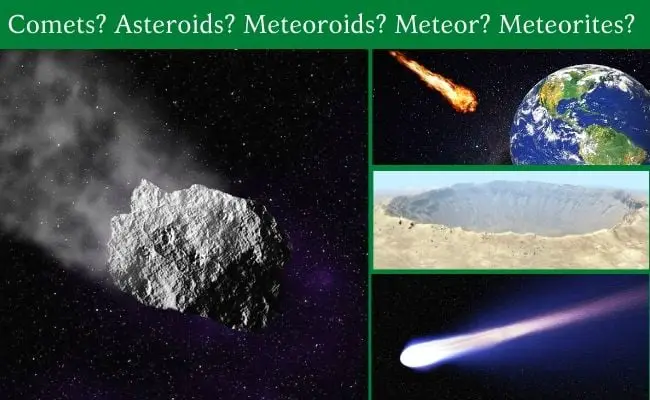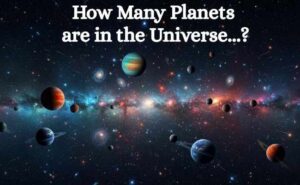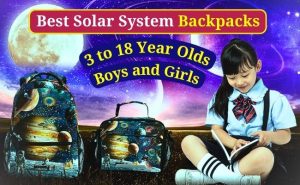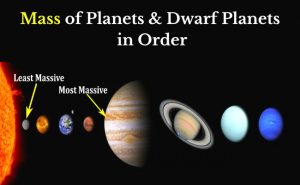There are many types of celestial bodies in our solar system. We humans have given them names according to their structure, behavior, or properties. But still, some space bodies confuse us to recognize them. So here we will know about the difference between Comets, Asteroids, Meteoroids, Meteor, Meteorites, and Bolides.
Generally, Comets, Asteroids, and Meteoroids directly orbit around the sun. Whereas Meteor, Meteorite, and Bolide are the related parts of the Meteoroids. In fact, Meteoroids are also a related part of the Comets or Asteroids.
What is the difference between Comets, Asteroids, Meteoroids, Meteor, Meteorites, and Bolides?
Here is a table given below that describes them briefly.
| Comets – Comets are small solar system bodies that directly orbit the sun. They are made of ice, gas, and dust particles. Their size can range from 100 meters to 30 kilometers. |
| Asteroids – Asteroids are rocky objects that orbit around the sun. They are smaller than planets and their size can range from 10 meters to 1000 kilometers. Though some asteroids are smaller than 10 meters. |
| Meteoroids – Meteoroids are debris of asteroids or comets that directly orbit the sun. There are millions of asteroids and comets in our solar system. When they collide and get broken then the broken parts (debris) of asteroids or comets called Meteoroids. Usually, they are smaller than 10 meters in size though there are no exact size dimensions for them. |
| Meteors – When the meteoroids enter into the atmosphere of the earth (or other planet’s atmosphere) they start burning up due to atmospheric friction. While burning up it shows trash of lights then this is called Meteors. They are also known as “shooting stars”. |
| Meteorites – Usually most of the meteors totally burn up in the atmosphere. But some survive and land on earth. The survived meteors called Meteorites. |
| Bolides – Bolides are very bright meteor in the atmosphere. Sometimes they explode in the atmosphere and create extremely bright light in the sky. They are also known as “Fireball”. A normal Bolide is as brighter as the full moon, whereas the Superbolide is could be 100 times brighter than the full moon. |
So these were the brief description of the comets, asteroids, meteoroids, meteor, meteorites, and bolide. Now let’s know about them in detail.
Asteroids and Comets
Asteroids and comets are bodies in our solar system that directly orbit the sun. They are comparatively smaller than planets. Here below know about them in detail:-
What are Comets?
Comets are icy bodies made of ice, gas, and dust. They exist beyond Neptune’s Orbit mostly in the Oort Cloud region. When they pass near to the sun they glow and release gas and dust. The glowing region of it called “Coma”.
When they reach near to sun the solar wind exerts pressure on the glowing released gases and dust then it creates glowing “Tails”. The Tails could be millions of Kilometers large. There are two types of tails created in a comet, Gas tail and Dust tail. You must be willing to know more about this astonishing celestial body.
- To know more about Comets, read this article: Comets: All About Comets in Our Solar System
What are Asteroids?
Asteroids are minor planets orbit around the sun. They are mostly made of rocks and minerals. There are millions of asteroids in our solar system. Most of them exist in the “Asteroid Belt” region between the orbit of Mars and Jupiter.
There are others such as ‘Near Earth Asteroids’ and ‘Trojan Asteroids’ including ‘Main Belt Asteroids’. Their size can range from few meters to 1000 kilometers. There are different types of asteroids, such as C type, S type, M type, and others.
- To know everything about this interesting object, check this article:- Asteroids: Types, and Near-Earth Asteroids with Facts.
Difference between Comets and Asteroids
Here are some important difference between Comets and Asteroids:-
| Comets | Asteroids |
| They are mostly made of Ice, Gas, and Dust particles. | They are mostly made of Minerals and Rocks. |
| Usually small in size and range from 100 meters to 30 kilometers (nucleus size). | They may vary from 1 meter to 1000 kilometers in size. |
| Comets produce Coma and Tails. | They do not show Coma and Tails. |
| Most of them exist beyond Neptune’s orbit. | Most of them exist in the Asteroid belt region (between the orbit of Mars and Jupiter). |
| As they locate farther their orbital period could be from 70 years to 100,000 years or even more. | They are near to Sun so their orbital period probably near or below 100 years. |
Meteors, Meteoroids, and Meteorites
Meteors, Meteoroids, and Meteorites are the debris of asteroids or comets. They are usually small in size and could be in millimeters to few meters.
Meteors and Meteorites are the related parts of Meteoroids. Meteors are phenomena when meteoroids enter into the atmosphere of the earth and burn totally due to friction. But if meteors survive and land on earth then those residue parts called Meteorites.
What are Meteoroids?
As we now know there are millions of asteroids and comets in our solar system. Sometimes asteroids or comets collide, they create a small piece (parts/debris) then this debris called Meteoroids. Mainly they are the space debris developed by the collision of celestial bodies. And they orbit in the same way as the collided object were orbiting.

Meteoroids orbit around the sun in the same manner as planets, asteroids, and comets do. They could be very small in size, roughly a few millimeters to 10 meters. Much smaller meteoroids are known as “micrometeoroids or space dust”.
What are Meteors?
When meteoroids enter into the atmosphere of earth, it burns or vaporizes due to atmospheric friction. While entering into the atmosphere they glow and the glowing streak of light is called Meteors.
You can usually see them in the night sky. They are also known as “shooting stars” or “falling stars”. So the meteoroid’s parts during the entering (burning) process into the atmosphere are called Meteors. And most of the meteors burn up totally in the sky and do not leave any residue.
Few meteors show the nature of incredibly bright and they are known as “Bolide”. Sometimes these bolide explodes in the atmosphere and then these bolides are also known as “Fireball”.
What are Meteorites?
Sometimes meteors do not burn totally in the atmosphere and some remain parts of meteors land on the earth. The remaining landed part is known as Meteorites. They are very small in size and vary from 1 millimeter to 1 meter in size.
If the meteorites are large they leave a big hole on the ground then these types of meteorites are known as “Crater”.
“According to an estimation, more than 25 million meteoroids, micrometeoroids, and space debris enter into the earth’s atmosphere every day. And due to this space debris, our earth receives almost 15000 tonnes of these materials in one year”.

Difference between Meteoroids, Meteors, and Meteorites
Here are some of the difference between Meteoroids, Meteors, and Meteorites given in the below table:-
| Meteoroids | Meteors | Meteorites |
| Meteoroids are small pieces of debris of large celestial objects. | Meteors are meteoroids entering into the earth’s atmosphere. | The remaining and landed parts of meteors are called Meteorites. |
| Their size can range roughly from few millimeters to 10 meters. | It gets burn up and destroy within the atmosphere, so does not have any size. | They are residue parts, so usually smaller than meteoroids. |
| They are also known as space debris. | It is also known as “shooting star” or “falling star”. | If Meteorites are big then it is also known as Crater. |
So these were the difference between Comets, Asteroids, Meteoroids, Meteor, Meteorites, and Bolides. Hope you must have liked reading about these celestial small objects. If you want to know more about our solar system and universe check below relevant articles of Planets Education.
- Also read:- Life Cycle of all the different Types of Stars
- Reference:- https://spaceplace.nasa.gov/asteroid-or-meteor/en/
- How Many Planets Exist in the Universe — A Cosmic Estimate
- 5 Best Solar System Backpacks in 2025
- Mass of Planets in Order from Lightest to Heaviest



